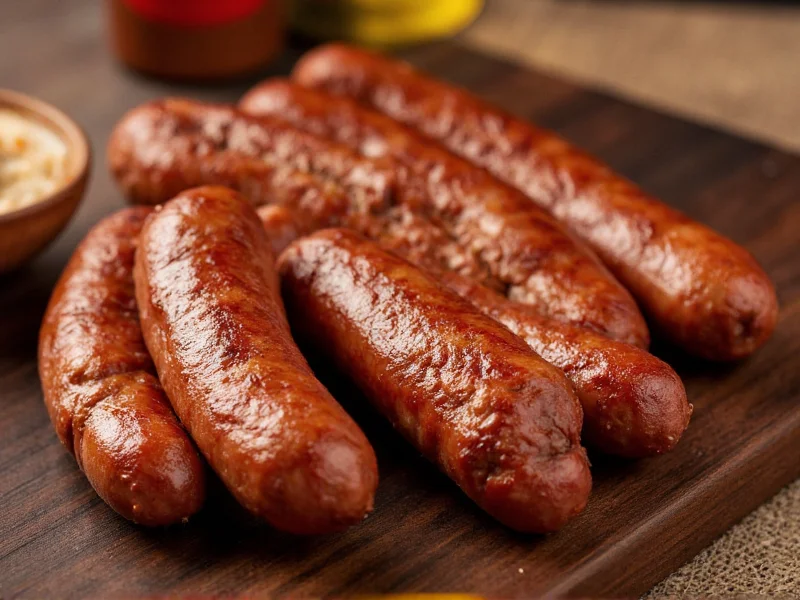Cajun sausage stands as a cornerstone of Louisiana cooking, bringing authentic regional flavor to countless dishes. Unlike mass-produced sausages, traditional cajun sausage features a coarser meat grind, higher fat content for juiciness, and a signature spice profile that balances heat with aromatic complexity. This distinctive sausage works exceptionally well in one-pot meals, gumbo, jambalaya, and as a standalone grilled item.
Defining Characteristics of Authentic Cajun Sausage
What sets genuine cajun sausage apart from generic 'spicy' sausages found in supermarkets? The answer lies in specific preparation methods and ingredient ratios. Authentic cajun sausage always contains:
- Coarsely ground pork (typically 70-80% lean to 20-30% fat ratio)
- Cayenne pepper as the primary heat source (not chili powder)
- Fresh garlic rather than garlic powder
- Black pepper in substantial quantities
- No fillers like breadcrumbs or soy protein
- Natural hog casings for proper texture
The spice blend follows a precise hierarchy where cayenne provides heat, paprika contributes color and earthiness, garlic adds pungency, and black pepper delivers sharpness. This combination creates what Louisiana chefs call "the holy trinity of heat"—a layered spiciness that builds gradually rather than hitting with immediate, one-dimensional burn.
Cajun Sausage vs. Andouille: Understanding the Differences
Many home cooks confuse cajun sausage with andouille, but these two Louisiana staples serve different culinary purposes. The key distinctions appear in both preparation and application:
| Characteristic | Cajun Sausage | Andouille |
|---|---|---|
| Meat Texture | Coarse grind, visible meat chunks | Finer grind, more homogenous |
| Primary Spice | Cayenne pepper dominant | Pepper blend with smoked notes |
| Smoking Process | Lightly smoked | Heavily smoked over pecan wood |
| Cooking Role | Main protein component | Flavoring agent |
| Heat Level | Moderate to high | Mild to moderate |
While cajun sausage typically serves as the primary meat in dishes like red beans and rice, andouille functions more as a flavor enhancer in gumbo due to its intense smokiness. Understanding this distinction helps home cooks select the appropriate sausage for authentic Louisiana recipes.
Traditional Preparation Methods
Authentic cajun sausage preparation follows techniques passed down through generations in Acadiana. The process begins with selecting quality pork shoulder (Boston butt), which provides the ideal fat-to-lean ratio. Butchers traditionally grind the meat twice—first through a coarse plate, then through a medium plate—to achieve the characteristic texture without over-processing.
The spice mixture gets incorporated while the meat is still cold, typically using a ratio of 3 tablespoons cayenne per 5 pounds of meat, adjusted based on regional preferences. Southwest Louisiana versions tend toward higher heat levels than those from the Bayou Teche region. After stuffing into natural hog casings, the sausages undergo a light smoking process at 160-180°F for 2-3 hours, just enough to infuse flavor without fully cooking the meat.
Best Practices for Cooking with Cajun Sausage
Maximizing cajun sausage's flavor potential requires specific cooking techniques. When preparing dishes featuring this sausage, follow these professional recommendations:
- Never boil cajun sausage—this leaches flavor and causes the casing to split
- Score the casing diagonally before grilling to prevent bursting while allowing fat to render
- Render the fat first when using in one-pot dishes to build flavor foundation
- Cook to 160°F internal temperature for food safety without drying out
- Let rest 5 minutes after cooking to redistribute juices
For gumbo and jambalaya, add cajun sausage during the early cooking stages to allow its fat and spices to permeate the entire dish. In red beans and rice, simmer the sausage gently to maintain its structural integrity while infusing the beans with flavor.
Selecting Quality Cajun Sausage
When shopping for authentic cajun sausage, look for these quality indicators:
- Natural casing rather than synthetic
- Visible meat texture through the casing
- Deep red color from paprika (not artificial coloring)
- Spice list featuring cayenne as the primary pepper
- No fillers like soy protein or breadcrumbs
- Refrigerated rather than frozen (indicates freshness)
Local Louisiana butchers and specialty meat markets typically offer the most authentic products. When purchasing online, look for producers who specify traditional preparation methods and regional origins. Avoid products labeled "cajun style" which often contain artificial flavors and lower quality ingredients.
Storage and Handling Guidelines
Proper storage maintains cajun sausage's quality and safety. Fresh cajun sausage keeps for 3-4 days in the refrigerator when stored in its original packaging. For longer storage, freeze portions in airtight containers for up to 3 months. Never thaw sausage at room temperature—always use refrigerator thawing to prevent bacterial growth.
When handling raw cajun sausage, use separate cutting boards and utensils from those used for ready-to-eat foods. Wash hands thoroughly after contact with raw sausage. Cooked sausage should reach an internal temperature of 160°F as measured by a food thermometer inserted into the thickest part.
Signature Dishes Featuring Cajun Sausage
Cajun sausage shines in traditional Louisiana preparations that showcase its unique flavor profile:
- Red Beans and Rice—simmered with kidney beans, onions, and bell peppers
- Cajun Sausage Skillet—with potatoes, bell peppers, and onions
- Grilled Cajun Sausage—served with mustard and crusty bread
- Cajun Sausage Gumbo—as a primary meat component
- Jalapeño-Stuffed Cajun Sausage—for added heat dimension
Each preparation highlights different aspects of the sausage's flavor and texture. The coarse grind holds up well in slow-simmered dishes while providing satisfying bite in grilled applications.
Regional Variations Across Louisiana
While cajun sausage follows consistent preparation principles, regional variations exist across Louisiana's culinary landscape. In the southwestern parishes near Lake Charles, sausages often feature higher cayenne content and additional garlic. The Acadiana region around Lafayette favors a more balanced spice profile with noticeable black pepper presence. Near the Mississippi River parishes, some versions incorporate a touch of sugar to balance the heat.
These regional differences reflect historical influences and local preferences, but all maintain the essential characteristics that define authentic cajun sausage. Understanding these variations helps cooks select products that match their preferred heat level and flavor profile.











 浙公网安备
33010002000092号
浙公网安备
33010002000092号 浙B2-20120091-4
浙B2-20120091-4